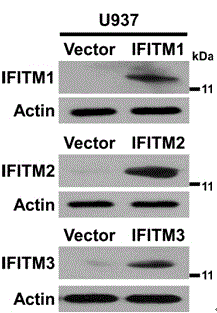Application of IFITM3 (interferon induced transmembrane protein 3) packaging exosome to preparation of dengue virus infection prevention medicine
A technology of transmembrane protein, dengue virus, applied in the field of protein engineering
- Summary
- Abstract
- Description
- Claims
- Application Information
AI Technical Summary
Problems solved by technology
Method used
Image
Examples
Embodiment 1
[0029] Embodiment 1: Construction, identification and extraction of pMSCV-IFITM recombinant plasmid
[0030] Download the IFITM1, IFITM2, and IFITM3 gene sequences from the GenBank database, and use the Primer Premier 5.0 software to design a pair of primers to amplify the full-length IFITM1 / 2 / 3 genes. The primers were synthesized by Shanghai Handsome Biotechnology Company. The primer series are as follows: the forward primer sequence is as follows : GGAAGATCTGCCATGAATCACACTGTCCAAACCTTC; reverse primer sequence is as follows: CCGGAATTCCTAAGCGTAGTCTGGGACGTCGTATGGGTATCCATAGGCCTGGAAGATCAG.
[0031]After the total cellular RNA was extracted by the Trizol method, the RNA concentration was measured with a nucleic acid protein quantifier. According to the measured concentration, all the RNA was diluted with RNase-free water to a final concentration of 1 μg / μl. We used the extracted cellular RNA to obtain the cDNA products of IFITM1 / 2 / 3 genes, and then amplified the products by PCR. T...
Embodiment 2
[0034] Example 2: Establishment of Stable and Highly Expressed Exogenous IFITM Cell Lines
[0035] 1. Calcium phosphate transfection to prepare retrovirus: Take dengue virus-susceptible cells HEK-293T and U937 in the logarithmic phase, respectively mix 20 μg of various recombinant plasmids, 20 μg of packaging plasmid pIK, 380 μl 1×TE, After mixing 60 μl 2M CaCl2, slowly add 480 μl 2×HEPES drop by drop, add the mixture evenly into HEK-293T medium, add 10 μl chloroquine (100 μM) at the same time and mix gently, place the cells in Cultured in a 37°C, 5% CO2 cell incubator.
[0036] 2. Collect the virus and infect U937 cells: collect the virus liquid at 8:00, 12:00, 16:00, 20:00, and 24:00 the next day, and filter it with a 0.22 μm pore size filter. Among them, the virus liquid collected at 8:00, 12:00, 16:00, and 20:00 was added to Polybrane (40 μg / ml) to infect U937 cells immediately, and the virus liquid collected at 24:00 was frozen and stored at -80 ℃ for later use. The resu...
Embodiment 3
[0039] Embodiment 3: Flow cytometry detection virus infection situation
[0040] Fix: remove the culture supernatant from the cells, wash 3 times with 1×PBS, then add 1×PBS to the cells, scrape the cells from the culture dish with a cell scraper, blow the cells gently and repeatedly with a pipette, and make a single cell suspension , transferred to a centrifuge tube, centrifuged at 1500 rpm, 4°C for 3 min. Discard the supernatant, wash the cells twice with pre-cooled 1×PBS, and centrifuge at 1500 rpm for 3 min. Remove the supernatant, add 1 ml 4% paraformaldehyde to resuspend the cells, fix at 37 °C for 10 min, and place on ice for 1 min.
[0041] Permeabilization treatment: After the cells are fixed, centrifuge to remove paraformaldehyde, add pre-cooled 90% methanol, mix well, and place on ice for 30 min.
[0042] Immunostaining: After cell permeabilization, centrifuge at 1500 rpm for 3 min at 4°C to remove methanol, wash 3 times with 1×PBS, then resuspend cells in 1×PBS co...
PUM
 Login to View More
Login to View More Abstract
Description
Claims
Application Information
 Login to View More
Login to View More - R&D
- Intellectual Property
- Life Sciences
- Materials
- Tech Scout
- Unparalleled Data Quality
- Higher Quality Content
- 60% Fewer Hallucinations
Browse by: Latest US Patents, China's latest patents, Technical Efficacy Thesaurus, Application Domain, Technology Topic, Popular Technical Reports.
© 2025 PatSnap. All rights reserved.Legal|Privacy policy|Modern Slavery Act Transparency Statement|Sitemap|About US| Contact US: help@patsnap.com



